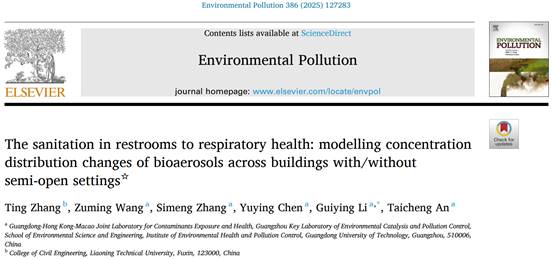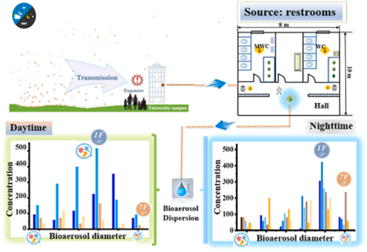近日,广东工业大学环境健康与污染控制研究院、环境科学与工程学院安太成教授团队与辽宁工程技术大学土木工程学院张婷教授在中国南、北方建筑公用卫生间生物气溶胶“释放-扩散-暴露“定量化研究方面取得最新研究进展,研究成果以《The sanitation in restrooms to respiratory health: modelling concentration distribution changes of bioaerosols across buildings with/without semi-open settings》为题(DOI: 10.1016/j.envpol.2025.127283)发表在Environmental Pollution (2025, 386, 127283)期刊上。论文的第一作者为张婷教授,主要作者包括硕士毕业生王祖明和博士生张思梦等,通讯作者为李桂英教授。
网址:https://doi.org/10.1016/j.envpol.2025.127283

建筑卫生状况因卫生间病原体释放而引发关注。本文对中国南、北方城市1–7层公共卫生间生物气溶胶的污染特征进行了对比分析。发现在南方城市采用半开放式卫生间的GD建筑中,高湿度(90%)傍晚时2.1–3.3 μm可培养生物气溶胶浓度(Cbio)达到峰值(483–1107 CFU/m³)。楼层越低,该粒径范围的Cbio浓度越高。在北方城市未采用半开放设计的LN建筑中,低湿度(20%)傍晚时1.1–2.1 μm Cbio达到峰值(554–907 CFU/m³),0.65–1.1 μm Cbio也较高(212–389 CFU/m3)。然而,两地建筑中的生物气溶胶总浓度均在1层达到峰值。值得注意的是,公共卫生间空气中存在大量鞘氨醇单胞菌、拟杆菌、假纤杆菌、蜡样芽孢杆菌、大肠杆菌、志贺菌、黑曲霉菌生物气溶胶。在通往卫生间的>4.5米走廊中,表皮葡萄球菌、金黄色葡萄球菌、芽孢杆菌及烟曲霉在水平方向大量存在。数学模型表明:吸入从卫生间扩散至室外建筑群的0.65–3.3微米生物气溶胶会增大健康风险。进一步的风洞实验证实:在相对湿度65%–90%、风速0.2–2.5米/秒的建筑环境中,可培养大肠杆菌生物气溶胶形成0.3–1.5米的水平扩散浓度梯度。该模型提示中国南方、北方城市建筑室内人为源传播生物污染物扩散浓度升高的差异,提示可能存在一定的高呼吸暴露风险。
英文摘要
The sanitation of buildings raises concerns due to pathogen release from restrooms. Herein, bioaerosol pollution profiles from buildings' public restrooms with/without semi-open settings were comparatively analyzed in two cities of China. For the GD building in Southern China with semi-open setting restrooms, the cultivable microbial concentration (Cbio) peaked on 2.1–3.3 μm particles (483–1107 CFU/m3) during the evening with high RH (90 %). Furthermore, the lower the floor, the higher the Cbio on 2.1–3.3 μm particles. For the LN building in Northern China without semi-open setting restrooms, the Cbio peaked on 1.1–2.1 μm particles (554–907 CFU/m3) during the evening with low RH (20 %). What's more, Cbio was also high (212–389 CFU/m3) on the finest particle (0.65–1.1 μm). However, the Cbio on each particle size was the highest at the 1st-floor for both buildings. Furthermore, the bioaerosol abundances of the genera Sphingomonas, Bacteroidetes, Pseudogracilibacillus, Cerasibacillus, Escherichia Shigella, Curvularia, and Aspergillus diffused in restrooms' air. In the >4.5-m corridor to restrooms, airborne Staphylococcus epidermidis, Staphylococcus aureus, Bacillus amyloliquefaciens, and Aspergillus fumigatus were abundant along the passages. A mathematical model showed that breathing in 0.65–3.3 μm bioaerosols from restrooms dispersing to outdoor architectural complexes increased health risks. A wind tunnel test explicated that 0.2–2.5 m/s winds of 65 %–90 % RH in the GD building increased 0.3–1.5 m horizontal diffusion concentration gradients of deposited cultivable Escherichia coli bioaerosols. The modeling highlights the airborne bio-pollutant diffusion-induced inhalation risks from sanitation systems in southern and northeastern cities.
图文摘要

项目资助:国家重点研发项目(2023YFC3708204)、粤港澳污染物暴露与健康联合实验室开放基金项目(GHMJLCEH-02)、国家自然科学基金(42130611和42007385)、辽宁省自然科学基金面上项目(2023-MS- 316)和辽宁工程技术大学高层次人才项目(21–1144)。